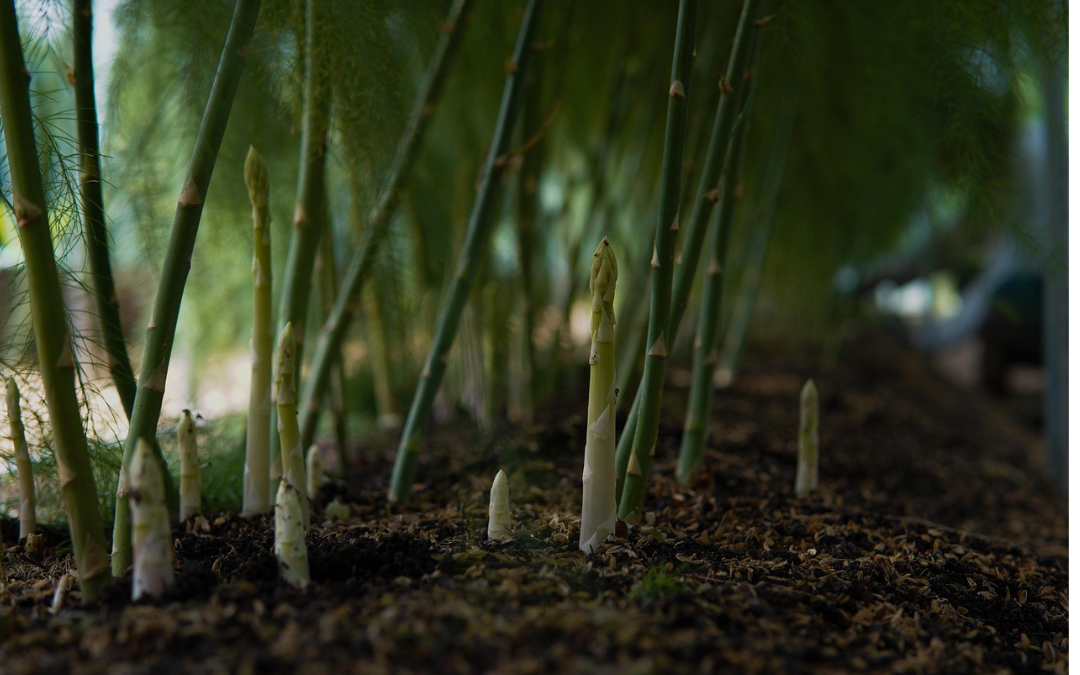Prime time to plant a bed of asparagus

Asparagus is a perennial vegetable that’s well worth growing. July is the perfect time to visit your local nursery and buy 2 year-old crowns. The bed you plant out now will produce fresh, succulent asparagus spears for the next 20 years.
Asparagus grows extremely well in Melbourne. Commercially it is grown at Koo Wee Rup in Gippsland, about 70km from Melbourne. This is considered the best area in the world for growing asparagus. The area produces 95% of Australia’s crop.
Varieties
Green: Mary Washington, Connover’s Colossal, Fat Bastard
Purple: Sweet Purple
Crowns or seeds?
While asparagus can be grown from seed, I don’t recommend that because it will be at least 4 years before you can harvest your first spears. It’s better to buy bare-rooted 2 year-old crowns from your local nursery and in the second year you can begin harvesting. In the first year of harvest, cut 2 or 3 spears per plant but the following year cut as much as you like – the lot! When buying crowns, examine the shoots and choose fleshy ones that look alive.
Position
Choose a sunny spot for best results but asparagus will grow, albeit more slowly, in partial sun. It does need a dedicated bed and you will need to plant a minimum of 4 crowns in a bed 1m x 1m. This will feed 2 people. Prepare a larger bed if you want to feed more people.
Soil and preparation
Asparagus likes open, friable, well-drained soil. The crowns are planted in a deep, wide trench which is then backfilled with a mix of soil, compost and aged manure. Create a mix of 2/3 soil and 1/3 nutrients. Effectively you are creating a rich environment to last 20 years. Dig a trench 40cm wide and 30cm deep with a flat bottom. Make a mound of soil about 10cm high the length of the trench and when planting, spread the roots out over the mound so that the top of the crown is supported and the roots fan out down the sides. Trim any broken roots. Cover with soil, leaving the crown at surface level. As the shoots emerge, cover them with a layer of compost and aged manure, and continue doing this until the top of the trench is reached.
pH
Asparagus prefers a pH of 6.5-7
Spacing
Space crowns 50-60cm apart, in rows 50-60cm apart
Weeding and mulching
Asparagus does not like competition from weeds so keep well weeded, do not grow annuals in the bed and mulch with sugar cane or lucerne.
Winter care
Once the spears begin to go to seed, it is vital you let them grow into ferny fronds. These will be quite tall. For the sake of tidiness and because they flop out of the bed, blocking paths, I usually stake each plant and tie the developing fronds to the stakes. Eventually the fronds will turn from green to yellow. Cut them to the ground at this point as the crowns will have absorbed the nutrients to provide for the following year.
Watering
Water regularly in summer and, if necessary, in winter too.
Harvesting
Harvest by using a sharp knife and cutting the stem just beneath the soil surface. Special curved knives can be purchased, but a sharp knife will do the job. Keep an eye on growth as asparagus can put on 3-4cm a day and it’s easy to miss the prime time to harvest. With a number of plants, you should be able to harvest every day.
Pests and diseases
Asparagus does not often suffer from pest attack. Diseases include asparagus rust (which attacks the ferny fronds), grey mould, and root and crown rot. These are all fungal diseases and I have never seen any of them in a home garden.
Written by Robin Gale-Baker
